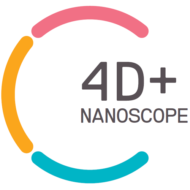![]() The last decade has seen substantial improvements in bone imaging, from conventional radio-absorptiometry (DEXA) that gives only a crude idea of the amount of calcified tissue (without any information about macro- or microarchitecture) to 3-D CT imaging. The X-ray radiation used for CT can penetrate the moderately dense organic-inorganic composite bone material to give imaging resolutions of 20 and 100µm for mice and humans, respectively. This permits differentiation of cortical and trabecular bone and the assessment of the trabecular network but is not good enough to resolve the sub-micron bone fine-structure which determines mechanical strength and remodelling properties. Bone analysis with a resolution sufficiently high to image osteocyte lacunae has so far been restricted to 3-D synchrotron X-ray analysis, but access is limited and the integration times exclude in vivo use.
The last decade has seen substantial improvements in bone imaging, from conventional radio-absorptiometry (DEXA) that gives only a crude idea of the amount of calcified tissue (without any information about macro- or microarchitecture) to 3-D CT imaging. The X-ray radiation used for CT can penetrate the moderately dense organic-inorganic composite bone material to give imaging resolutions of 20 and 100µm for mice and humans, respectively. This permits differentiation of cortical and trabecular bone and the assessment of the trabecular network but is not good enough to resolve the sub-micron bone fine-structure which determines mechanical strength and remodelling properties. Bone analysis with a resolution sufficiently high to image osteocyte lacunae has so far been restricted to 3-D synchrotron X-ray analysis, but access is limited and the integration times exclude in vivo use.
Correlative studies of bone using electron microscopy and other spectroscopies are still in their infancy. Secondary ion mass spectrometry at sufficiently high resolution is challenging and has not often been used, although the PI SC has obtained first promising results with a modified focused ion beam microscope (unpublished). Raman spectroscopy of bone is also not often used, but SC has recently published some of the first results showing the applicability of Raman to advanced bone characterization. Raman spectroscopy is useful for the study of bone because of its chemical specificity, able to distinguish the main components of bone including phosphate, carbonate, and the collagen matrix. This specificity enables assessment of the chemical composition and fibrillar organization of bone materials in a non-invasive and label-free manner with a resolution approaching the diffraction limit of about 500nm. Such chemical imaging techniques allow changes in bone composition, structure, and mineralization to be related to mechanical properties on a sub-micron scale.
A significant part of the project’s work will be to modify a state-of-the-art XRM in order to make it about 100 times faster, so that living subjects and blood flow in bones can be studied. This will involve anticipated improvements in detector and X-ray source technology, as well as a synergetic coupling of hardware with software (using ‘precision learning’ techniques) to be developed by the project team. The project will also further improve Raman and FIB-SIMS technologies for bone imaging. A unique feature of this project will be the continuous and correlated use of multiple imaging techniques and spectroscopies to thoroughly characterize bone sections using well understood and easy to interpret techniques, and to make the jump to 3-D reconstruction and analysis of these datasets (simultaneously using all information – i.e. correlative microscopy) for comparison to the X-ray data sets (both ex vivo and in vivo).
